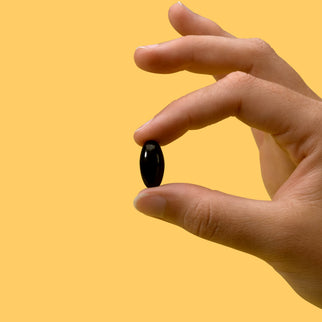Fats have been one of the most controversial nutrients in the health world for decades — should we consume them, or should we avoid them? Today we know that fat intake is essential for supporting our bodies, but some forms are better than others.
When it comes to omega-3s and omega-6s, they are both important and necessary, but omega-6 can have some conflicting reports and just how much you need. To determine whether your omega-3 to omega-6 ratio is healthy, you should consider a few different factors.
What Are Omega-3 Fatty Acids?

Omega-3 fatty acids are a type of polyunsaturated fatty acid (PUFA) that makes up an important building block of cells in our bodies. Omega-3s are a key part of cell membranes, which means they not only help to form cells but also influence interactions between them. As a result, these essential fatty acids help to support healthy function in several bodily systems.
There are three main types of omega-3 fatty acids, which are:
- Alpha-linolenic acid (ALA), a short-chain omega-3 precursor
- Eicosapentaenoic acid (EPA)
- Docosahexaenoic acid (DHA)
Of the three different types of omega-3s, ALA is the easiest to obtain as it is the most abundant form of omega-3 in Western diets. However, DHA and EPA are the two most crucial omega-3s that provide benefits as they have a larger role in the body. That said, they are also found in fewer foods.
Altogether, omega-3 fatty acids are an essential part of our diets and offer many potential health benefits, like:
- Supporting heart health
- Helping to maintain cholesterol levels already within a healthy range
- Supporting a healthy blood pressure
- Supporting healthy joints
- Supporting cognitive function
- Supporting overall emotional wellness and a positive mood
For women, omega-3 fatty acids provide additional health benefits, especially during pregnancy and breastfeeding, as they help support the healthy growth and development of a child. Men may also experience additional benefits from consuming omega-3 fats, like healthy circulation and heart health.
What Are Omega-6 Fatty Acids?

Like omega-3, omega-6 is another type of PUFA. These two types of fatty acids are differentiated in their molecule shape. In omega-3, the first double bond occurs on the third carbon atom, whereas in omega-6, it occurs on the sixth carbon atom.
As with omega-3 fatty acids, omega-6 fatty acids serve an important role in the body as they also help form cell membranes. With their role in the body, omega-6s provide their own benefits by potentially supporting a healthy heart and circulation.
The most common forms of omega-6 are linoleic acid and arachidonic acid. Linoleic acid cannot be made by the body, so it is essential to consume it through your diet. However, that is generally not difficult since you can find omega-6 fats in many common foods, especially in Western diets. Some common food sources of omega-6 fats include:
- Peanut butter
- Corn oil
- Safflower oil
- Sunflower oil
- Soybean oil
- Sunflower seeds
- Hemp seeds
- Walnuts
Why Does Your Fatty Acid Ratio Matter?
As with many things, too much of a good thing can be a problem. When it comes to omega-6 fatty acids, this appears to be the case, although there is some conflicting evidence. Consuming omega-6 fats in moderation can help to promote heart health, but a ratio that is too high in omega-6 may lead to an increased risk of negative health outcomes, according to some research.
Some types of omega-6 fatty acids are pro-inflammatory. Specifically, arachidonic acid is a precursor to pro-inflammatory lipid mediators in the body, like prostaglandins, signaling the cells to remain in an inflammatory state. As a result, high omega-6 consumption can lead to this consistent signaling.
Omega-3, on the other hand, may work to counteract this process, as it helps to support an overall healthy inflammatory response in the body.
There is still a large amount of research to be done surrounding the potentially negative effects of omega-6 fats, so it may be a good idea to consume them in moderation. Which types of omega-6s you consume may also make a difference, as some forms of omega-6s are healthier than others.
For example, in addition to the list above, foods like potato chips, fast food burgers, cakes, and other processed foods are also high in omega-6 fatty acids. As you may assume, eating a handful of walnuts is often better than eating a handful of potato chips. Ultimately where you get your omega-6s and what other nutrients come with it may be a key point to consider.
What Is a Good Fatty Acid Ratio?
Regardless of how you get your omega-6s, it is helpful to know how much you should consume, especially since maintaining a healthy ratio of omega-3 to omega-6 can support a healthy heart. An exact optimal ratio for omega-3 to omega-6 is still up for debate in the medical community, but the amount of each that you should consume each day is clearer.
In an American diet, the average person eats as much as 10 times more omega-6 fats than omega-3s, so most people could stand to be more mindful about balancing the two. The best way to balance these two nutrients is to consume more omega-3s. Each day you should strive to obtain at least 250mg of EPA and DHA omega-3s and at least 1.1 to 1.6 grams of ALA. Consuming regular amounts of omega-3 will help you support each cell in your body and contribute to overall wellness.
When considering the best intake of omega-6s in your diet, you should not leave them out entirely. Omega-6 fatty acids are generally recognized as a better alternative than saturated fats in your diet, giving you another reason to include them.
The optimal ratio between the two likely depends on your health circumstances. However, ultimately, the optimal omega-6 to omega-3 ratio is likely somewhere between 2 to 1 and 5 to 1. Research shows that a ratio of 10 to 1 or higher may start to demonstrate adverse health effects.
How Can I Maintain a Healthy Omega-3 to Omega-6 Ratio?

Maintaining a healthy ratio of omega-6 to omega-3 fatty acids can be a significant challenge in western diets since many foods are high in omega-6 and few contain omega-3. To ensure you are not overdoing it with foods high in omega-6s, avoid processed foods like cured meats and fast food. In general, high consumption of processed foods can have a range of potential risk factors.
The best way to improve your ratio of omega-6 to omega-3 is to include more sources of omega-3 in your diet. For example, flaxseed and vegetable oils, like olive oil and canola oil, are powerful sources of omega-3 fats and make great additions to your diet. However, these sources only contain ALA omega-3s.
Chia seeds are another popular source of omega-3s — be aware, though, that chia seeds and seed oils only contain ALA, which are less beneficial than other forms, so you still need to include sources of DHA and EPA for a complete diet.
Fortunately, there are multiple ways to obtain EPA and DHA in your diet. The most popular way to obtain these two essential fatty acids is by eating fatty fish like mackerel, sardines, and salmon. Fish oil supplements take the omega-3-rich oil from these fish and provide a more convenient way to receive these vital nutrients, either in a small capsule or by the spoonful. Krill oil is a similar option that comes from small crustaceans.
However, many people prefer to avoid fish and fish oil because of seafood allergies, the risk of mercury contamination, or because they follow a plant-based diet. Additionally, fish oil supplements tend to have a fishy taste and can lead to fishy burps after the fact — something many consumers would rather avoid.
On the bright side, algae provides a more effective and entirely plant-based way to obtain both EPA and DHA.iwi life’s omega-3 supplement provides combined DHA and EPA with a better absorption rate than fish or krill oil. So whether you want to avoid fish or not, iwi life is the all-around better option for anyone.
Start Supporting a Healthy Omega-6 to Omega-3 Ratio
Keeping your omega-3 to omega-6 ratio in balance is a great way to support your heart health and overall wellness. Being mindful of the amount of omega-6 you consume is an excellent way to support a healthy balance and promote optimal health. However, increasing your omega-3 intake also plays a vital role, and it is an easier step to take than you might think.
For an easy way to include omega-3 and healthy omega-6 in your diet, iwi life algae-based Omega-3 supplements are an excellent option. With just one daily softgel, you can enjoy a complete 250mg of combined EPA and DHA, not to mention all the possible benefits that come with it. Explore our complete family of algae-based omega-3 supplements and see all of the potential benefits for yourself.
Sources:
Omega-6 fatty acids and inflammation | ScienceDirect
The importance of the ratio of omega-6/omega-3 essential fatty acids | PMC





















